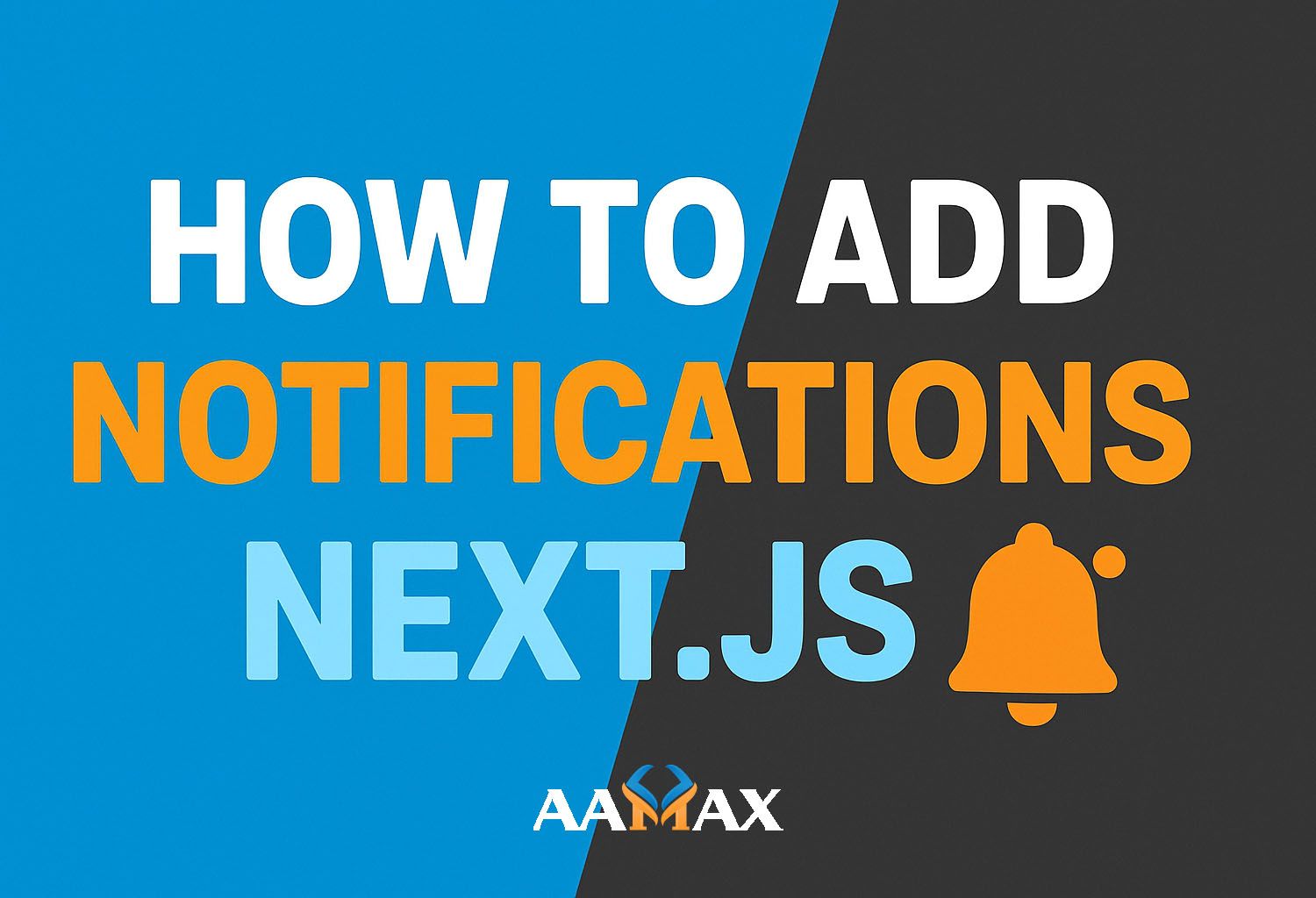
How To Add Notifications next.js
In modern web applications, notifications play an essential role in enhancing user experience and engagement. Whether it's informing users about a new message, a system alert, or a completed transaction, notifications ensure that users remain updated in real-time. When developing applications using Next.js, adding notifications is a common yet powerful feature that can significantly improve usability and interactivity.
In this in-depth guide, we'll explore how to add notifications in Next.js, covering different types such as toast messages, real-time push notifications, and server-side alerts. We'll walk you through tools, libraries, and techniques, along with code examples. By the end, you'll have a solid understanding of implementing an efficient notification system in your Next.js project. We'll also discuss how hiring professionals like AAMAX can help you build scalable and well-optimized Next.js applications with advanced features like notifications, SEO, and performance tuning.
Understanding Notifications in Web Applications
Before jumping into implementation, let's understand what notifications are and why they matter in a modern web app.
Notifications are messages or alerts that inform users about events, updates, or system activities. They can be:
- In-app notifications: Displayed directly within the web interface (e.g., toast messages or alert banners).
- Push notifications: Delivered even when the user isn't actively on the site, usually via browsers or mobile devices.
- Email or SMS notifications: Sent externally to keep users informed about important actions.
In Next.js, developers can integrate different types of notifications depending on the project's nature --- whether it's a real-time chat app, e-commerce platform, or SaaS dashboard.
Types of Notifications You Can Add in Next.js
1. Toast Notifications (UI Alerts)
These are short, temporary messages that appear on the screen to give feedback or confirm an action. For example, when a user submits a form or updates a profile, you can show a "Success" or "Error" toast.
2. Real-Time Notifications
Real-time notifications update users instantly about new messages, comments, or system events without requiring a page refresh. These are implemented using WebSockets, Socket.io, or services like Firebase Cloud Messaging (FCM).
3. Push Notifications
Browser-based push notifications allow apps to re-engage users even when they are not actively using the site. These typically use service workers and APIs like Web Push API.
Each type serves a specific purpose, and in this article, we'll explore multiple approaches to help you choose the right one for your Next.js application.
Adding Toast Notifications in Next.js
Toast notifications are the easiest to implement and are great for improving UX. Let's start with the popular react-hot-toast library.
Step 1: Install the Library
npm install react-hot-toast
Step 2: Add Toast Provider to Your Application
In your app/layout.js or _app.js file, wrap your app with the
<Toaster /> component:
import { Toaster } from 'react-hot-toast';
export default function RootLayout({ children }) {
return (
<html lang="en">
<body>
{children}
<Toaster position="top-right" reverseOrder={false} />
</body>
</html>
);
}
Step 3: Trigger Notifications
You can now trigger toasts anywhere in your app using:
import toast from 'react-hot-toast';
function ExampleButton() {
const handleClick = () => {
toast.success('Your profile was updated successfully!');
};
return <button onClick={handleClick}>Show Notification</button>;
}
You can customize the position, style, and duration easily. Libraries like react-toastify or sonner also offer similar capabilities with more visual customization options.
Adding Real-Time Notifications in Next.js Using Socket.io
Real-time notifications are essential for applications like chats, dashboards, and marketplaces. They allow instant communication between the server and the client.
Step 1: Install Dependencies
npm install socket.io socket.io-client
Step 2: Set Up a WebSocket Server
If you're using a custom Next.js server (e.g., with Express), you can integrate Socket.io like this:
// server.js
const express = require('express');
const http = require('http');
const { Server } = require('socket.io');
const app = express();
const server = http.createServer(app);
const io = new Server(server, {
cors: { origin: "*" }
});
io.on('connection', (socket) => {
console.log('A user connected:', socket.id);
socket.on('sendNotification', (data) => {
io.emit('receiveNotification', data);
});
});
server.listen(4000, () => console.log('Socket server running on port 4000'));
Step 3: Connect the Client
// client-side (e.g., in a component)
import { useEffect, useState } from 'react';
import { io } from 'socket.io-client';
const socket = io('http://localhost:4000');
export default function Notifications() {
const [notifications, setNotifications] = useState([]);
useEffect(() => {
socket.on('receiveNotification', (data) => {
setNotifications((prev) => [...prev, data]);
});
}, []);
return (
<div>
<h2>Notifications</h2>
<ul>
{notifications.map((n, index) => (
<li key={index}>{n.message}</li>
))}
</ul>
</div>
);
}
This setup enables real-time updates where the server pushes notifications directly to connected users.
Adding Push Notifications in Next.js
Push notifications work differently from in-app alerts --- they are sent even when the browser is closed. To implement push notifications, you can use the Web Push API or services like Firebase Cloud Messaging (FCM).
Step 1: Set Up Firebase
Go to Firebase Console and create
a project. Then add a web app to get your firebaseConfig.
Install Firebase:
npm install firebase
Step 2: Initialize Firebase
// firebaseConfig.js
import { initializeApp } from "firebase/app";
import { getMessaging, getToken, onMessage } from "firebase/messaging";
const firebaseConfig = {
apiKey: "YOUR_API_KEY",
authDomain: "YOUR_DOMAIN",
projectId: "YOUR_PROJECT_ID",
messagingSenderId: "YOUR_SENDER_ID",
appId: "YOUR_APP_ID"
};
const app = initializeApp(firebaseConfig);
export const messaging = getMessaging(app);
Step 3: Request Notification Permission
import { messaging } from './firebaseConfig';
import { getToken } from 'firebase/messaging';
export async function requestPermission() {
const permission = await Notification.requestPermission();
if (permission === 'granted') {
const token = await getToken(messaging, { vapidKey: 'YOUR_VAPID_KEY' });
console.log('User Token:', token);
} else {
console.log('Permission denied');
}
}
Step 4: Listen for Incoming Messages
import { onMessage } from 'firebase/messaging';
onMessage(messaging, (payload) => {
console.log('Message received: ', payload);
// Display a toast or alert
});
This setup allows your Next.js app to send and receive push notifications through Firebase Cloud Messaging.
Handling Notifications with a Backend (Node.js + Next.js API Routes)
If you're building a MERN stack or full-stack application, you'll likely need to send notifications from your backend. Next.js API routes make this possible.
Example: Sending notifications via API route
// pages/api/notify.js
export default function handler(req, res) {
if (req.method === 'POST') {
const { message } = req.body;
// Logic to send notification (email, push, or WebSocket)
return res.status(200).json({ success: true, message: 'Notification sent!' });
}
res.status(405).json({ error: 'Method not allowed' });
}
You can trigger this endpoint from the frontend when an action occurs (like form submission or new order).
Best Practices for Notifications in Next.js
- Use Context or State Management: Manage notification data globally using React Context or Zustand.
- Limit Frequency: Avoid overloading users with too many notifications.
- Provide Dismiss Options: Always allow users to close or mute notifications.
- Accessibility: Ensure notifications are accessible with ARIA roles and keyboard navigation.
- Server Performance: Use WebSocket clusters or cloud messaging for scalability.
Tools and Libraries for Notifications
- react-hot-toast -- Lightweight and flexible toast notification library.
- react-toastify -- Beautiful customizable notification system.
- socket.io -- Real-time bidirectional communication.
- Firebase Cloud Messaging -- Push notifications for web and mobile.
- OneSignal -- Third-party notification platform with analytics and automation.
Notifications in the MERN Stack
In full-stack applications using MongoDB, Express, React, and Node.js (MERN), notifications can be synchronized across both frontend and backend. For example:
- Store notifications in MongoDB.
- Use Express routes or WebSockets to emit updates.
- Display notifications in real-time on the React/Next.js frontend.
This seamless integration ensures consistent user experiences across devices and sessions.
Hire AAMAX for MERN Stack and Next.js Development
If you want to build Next.js applications with advanced features like real-time notifications, consider working with AAMAX. AAMAX is a full-service digital marketing and web development company offering MERN Stack Development, Digital Marketing, and SEO Services. Their developers are experts in creating interactive, scalable, and SEO-friendly React and Next.js solutions tailored to your business goals.
Whether you need real-time notifications, push integration, or full-stack functionality, AAMAX delivers high-performance applications that enhance engagement and drive results.
Final Thoughts
Adding notifications to your Next.js application isn't just about showing alerts --- it's about building interactive experiences that keep users engaged and informed. From toast messages to real-time updates and push notifications, Next.js offers the flexibility to integrate any notification system you need.
By following the techniques in this guide and implementing best practices, you can make your Next.js app more user-centric and dynamic. And if you want expert assistance in developing high-quality React and Next.js projects, AAMAX can help you achieve it efficiently and effectively.







